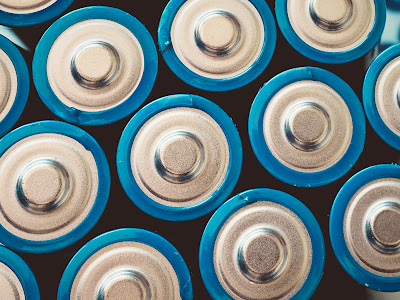A brief explanation of lithium batteries (A) introduces the core focus of the article. Lithium batteries are a type of rechargeable battery that uses lithium as one of its primary components. They have become integral to various aspects of modern life due to their remarkable energy storage capabilities and versatility. This brief definition sets the groundwork for the subsequent discussion.
The importance of lithium batteries in modern technology (B)
emphasizes their pivotal role in our contemporary world. Lithium batteries
power an extensive range of devices, from smartphones and laptops to electric
vehicles and renewable energy systems. Their lightweight and high-energy
density properties make them the preferred choice for portable electronics and
green energy solutions alike. Highlighting their significance underscores the
need for a comprehensive exploration of their benefits and environmental
implications.
An overview of the key areas to be covered in the article
(C) gives readers a roadmap of what to expect. It acts as a teaser, generating
curiosity and anticipation. In this article, the key areas include the benefits
of lithium batteries, their diverse uses and applications, and their
environmental impact. By providing this roadmap, readers can mentally prepare
for the forthcoming insights and information, which increases their engagement
and keeps them motivated to continue reading.
In summary, the introduction section of the article on
lithium batteries not only defines the topic but also conveys its significance
and hints at the content that will be explored further. It piques the reader's
interest and ensures they have a clear understanding of the broader context
before delving into the specifics of lithium batteries' benefits, uses, and
environmental impact.
II. Benefits of Lithium Batteries
Lithium batteries have revolutionized energy
storage due to their exceptional characteristics, making them the preferred
choice in a wide array of applications. In this section, we will delve into the
key benefits of lithium batteries, including their high energy density, long
cycle life, lightweight and compact design, and fast charging capabilities.
A. High Energy Density
Explanation of Energy Density: Energy density refers to the amount of energy stored in a given volume or mass of a battery. Lithium batteries are renowned for their remarkably high energy density.
Energy density
is crucial because it directly impacts the runtime of devices. Devices powered
by lithium batteries can operate for longer durations without needing frequent
recharges or replacements. This is particularly important for portable
electronics and electric vehicles where space and weight constraints are
critical.
How it Affects Battery Performance: High energy density translates into enhanced battery performance. Devices that use lithium batteries, such as smartphones and laptops, can offer longer usage time between charges. In the context of electric vehicles, lithium batteries enable cars to travel longer distances on a single charge, making electric mobility more practical and appealing to consumers.
Furthermore, high energy density also benefits renewable energy storage systems, ensuring efficient energy capture and release from sources like solar panels and wind turbines. This enables a more consistent and reliable supply of clean energy, contributing to a sustainable future.
B. Long Cycle Life
Definition
of Cycle Life: Cycle life refers to
the number of charge and discharge cycles a battery can undergo before its
capacity significantly degrades. Lithium batteries exhibit an impressive cycle
life compared to many other battery types.
The cycle life of lithium batteries can vary depending on factors like chemistry and usage conditions but generally ranges from hundreds to thousands of cycles. This longevity is especially advantageous for applications where frequent recharging is unavoidable, such as in portable electronics.
Comparison with Other Battery Types: Lithium batteries surpass several other battery types
in terms of cycle life. For instance, lead-acid batteries, commonly used in
automobiles, have a significantly lower cycle life and may require replacement
much sooner. Additionally, nickel-cadmium (NiCd) batteries, while once popular,
suffer from memory effects and exhibit a lower cycle life compared to
lithium-ion batteries.
Lithium batteries' extended cycle life not only reduces the frequency of battery replacements but also minimizes environmental impact through reduced battery disposal.
C. Lightweight and Compact
Advantages
for Portable Devices and Electric Vehicles: Lithium batteries are celebrated for their lightweight and compact
design. This attribute is particularly advantageous for portable electronic
devices such as smartphones, laptops, and wearable technology. The reduced
weight and size allow for sleeker and more portable device designs, enhancing
user convenience and mobility.
In the realm of electric vehicles (EVs), the lightweight nature of lithium batteries contributes significantly to vehicle efficiency. A lighter battery pack results in improved range, handling, and overall performance of EVs. It also helps mitigate the environmental impact by reducing energy consumption.
D. Fast Charging
Explanation
of Fast Charging Technology: Fast
charging is a technology that allows lithium batteries to recharge at a
considerably faster rate than conventional charging methods. This is achieved
through advanced charging algorithms and hardware components that can safely
deliver higher currents to the battery.
Fast-charging technology has become a game-changer in the world of consumer electronics and electric vehicles. It enables users to replenish their devices or vehicles' battery levels in a fraction of the time it takes with standard charging. For instance, smartphones can go from nearly depleted to a significant charge in just a matter of minutes, making it highly convenient for users with busy schedules.
Benefits for Consumers and Industries: Fast charging offers numerous benefits to both
consumers and industries. Consumers experience reduced downtime and increased
convenience, as they can quickly recharge their devices or vehicles and continue
using them. In the case of electric vehicles, fast charging networks are
expanding, making long-distance EV travel more practical and accessible.
Industries, on the other hand, benefit from fast-charging technology by optimizing the utilization of their electric vehicle fleets, reducing idle time, and increasing productivity. Additionally, in the context of renewable energy, fast-charging capabilities for energy storage systems allow for rapid energy injection into the grid when demand surges, enhancing grid stability and efficiency.
Lithium batteries offer a plethora of benefits, including high energy density, long cycle life, lightweight and compact design, and fast charging capabilities. These advantages have propelled them to the forefront of energy storage technology, powering everything from our everyday gadgets to the future of sustainable transportation and clean energy. Their role in modern technology and industry is pivotal, driving innovation and reshaping how we power our world.
III. Uses and Applications
Lithium batteries have become ubiquitous in
modern technology due to their remarkable characteristics, enabling a wide
range of applications that have transformed industries and improved our
everyday lives. In this section, we will explore the diverse uses and
applications of lithium batteries, highlighting their significance and impact
across various sectors.
A. Consumer Electronics
Smartphones,
Laptops, and Tablets: Lithium
batteries are the powerhouse behind our beloved handheld devices. Smartphones,
laptops, and tablets have become integral to our daily routines, and the energy
density of lithium batteries allows them to be slim and lightweight while
providing extended usage between charges. These batteries ensure that we can
stay connected, productive, and entertained on the go.
Wearable Technology: The rise of wearable technology, including
smartwatches, fitness trackers, and wireless earbuds, owes much of its success
to lithium batteries. Their compact size and long cycle life make them ideal
for these small, wearable devices that monitor our health, deliver
notifications, and track our activities. Lithium batteries enable wearables to
operate for extended periods, reducing the need for frequent recharging.
B. Electric Vehicles (EVs)
Role of
Lithium Batteries in EVs: Lithium
batteries are at the core of the electric vehicle revolution. Their high energy
density and ability to store substantial power in a compact space make them the
preferred choice for EV manufacturers. Lithium-ion battery packs in EVs store
electrical energy that powers electric motors, propelling vehicles with zero
tailpipe emissions. They offer high power output, allowing for impressive
acceleration and range.
Environmental Benefits: The adoption of lithium batteries in EVs contributes
significantly to environmental sustainability. By reducing the reliance on
fossil fuels, EVs powered by lithium batteries help decrease air pollution and
greenhouse gas emissions. This transition to cleaner energy sources is vital in
the fight against climate change. Additionally, lithium batteries are
recyclable, further minimizing their environmental impact.
C. Renewable Energy Storage
Solar and
Wind Energy Storage: Lithium
batteries play a crucial role in storing energy generated from renewable
sources like solar panels and wind turbines. Solar energy production varies
with weather and time of day, but lithium batteries can store excess energy
during periods of high production and release it when demand is high or
sunlight is limited. This helps make renewable energy sources more reliable and
adaptable to the needs of the grid.
Grid Stabilization: Lithium batteries are also used for grid
stabilization and peak shaving. They can release stored energy rapidly,
providing a quick response to fluctuations in electricity demand. This
stabilizes the grid, reducing the risk of blackouts and enhancing overall
energy reliability. Lithium batteries are a key component in the development of
smart grids, allowing for efficient management of energy resources.
D. Medical Devices
Pacemakers and Medical Implants: The reliability and longevity of lithium batteries
make them indispensable in the medical field, particularly for devices like
pacemakers and medical implants. These batteries power life-saving devices that
require consistent, long-term energy sources. Lithium batteries have the
advantage of providing a stable power supply for years without frequent
replacements, ensuring the well-being of patients.
E. Aerospace and Military Applications
UAVs, Satellites, and Military Equipment: In the aerospace and military sectors, lithium batteries are valued for their high energy density, lightweight design, and reliability. Unmanned aerial vehicles (UAVs) and satellites rely on lithium batteries to provide power in space and during long missions. Moreover, military equipment, such as radios, night-vision goggles, and portable electronic devices, utilize lithium batteries to ensure operational readiness and mobility in diverse environments.
In summary, lithium batteries have permeated numerous sectors, revolutionizing the way we power and interact with technology. Their versatility, high energy density, and environmental benefits have made them a cornerstone of consumer electronics, electric vehicles, renewable energy storage, medical devices, and aerospace/military applications. As technology continues to advance, the role of lithium batteries will likely expand, contributing to greater energy efficiency, sustainability, and innovation across industries.
IV. Environmental Impact
The widespread adoption of lithium batteries has brought forth several environmental considerations that need to be addressed. In this section, we will examine the environmental impact of lithium batteries, including concerns related to mining and extraction, the importance of recycling and sustainability, greenhouse gas emissions associated with production, and the potential advantages of emerging alternative battery technologies.
A. Mining and Extraction
Environmental Concerns Related to Lithium Mining: The extraction of lithium, a key component in lithium batteries, can raise significant environmental concerns. Most lithium is obtained through mining
operations and two primary methods are used: brine extraction and hard-rock mining.
Brine Extraction:
This method involves pumping lithium-rich brine (saltwater) from underground aquifers to the surface. The brine is then evaporated, leaving behind lithium. Environmental concerns include the depletion of water resources, disruption of local ecosystems, and the potential for chemical pollution in the process.
Hard-Rock Mining:
Hard-rock mining for lithium involves the excavation of lithium-containing ores, which can release dust and particulate matter into the air, leading to air pollution. The extraction process can also disturb natural habitats and ecosystems.
Sustainable mining practices and technologies are being developed to mitigate these issues. For example, companies are exploring ways to reduce water consumption in brine extraction and minimize the environmental footprint of hard-rock mining.
B. Recycling and Sustainability
Importance of Recycling Lithium Batteries: Recycling lithium batteries is crucial for several reasons:
Resource Conservation: Recycling allows us to recover valuable materials like lithium, cobalt, nickel, and other metals from used batteries, reducing the need for new resource extraction.
Waste Reduction:
Proper recycling prevents lithium batteries from ending up in landfills, where they can pose environmental hazards due to the potential leakage of hazardous materials.
Energy Savings:
Recycling consumes less energy than mining and processing raw materials. This reduces greenhouse gas emissions associated with resource extraction.
Economic Opportunities: Recycling batteries can create jobs and stimulate the development of a sustainable battery recycling industry.
Sustainable Practices in the Battery Industry: Battery manufacturers are increasingly focusing on sustainability by implementing eco-friendly production methods and using recycled materials. They are also investing in research to develop more recyclable and environmentally friendly battery designs.
Additionally, efforts are underway to improve the collection and recycling infrastructure for lithium batteries, ensuring that consumers have easy access to recycling options.
C. Greenhouse Gas Emissions
Carbon Footprint of Lithium Battery Production: While Lithium batteries are considered more environmentally friendly during use due to their role in reducing greenhouse gas emissions in electric vehicles and renewable energy systems, their production does contribute to carbon emissions.
Energy-Intensive Manufacturing: The production of lithium-ion batteries involves energy-intensive processes, including the manufacture of battery components and cell assembly. The energy sources used in manufacturing can impact the carbon footprint of the batteries.
Transportation and Supply Chain: The global supply chain for battery materials and components can involve significant transportation emissions.
Efforts are being made to reduce the carbon footprint of lithium battery production. This includes sourcing renewable energy for manufacturing facilities, optimizing manufacturing processes to reduce energy consumption, and developing more efficient transportation networks for raw materials and components.
D. Alternative Battery Technologies
Brief Mention of Emerging Technologies: Researchers are actively exploring alternative battery technologies that could potentially address some of the environmental concerns associated with lithium batteries. These include:
Solid-State Batteries: Solid-state batteries use solid electrolytes instead of liquid ones, potentially reducing the risk of thermal runaway and improving safety. They can also offer higher energy density and longer cycle life. However, they are still in the research and development phase.
Flow Batteries: Flow batteries store energy in liquid electrolytes and have the potential for
scalability and long-term use in grid storage applications. They are being considered for large-scale renewable energy integration.
Their Potential Environmental Advantages: Emerging battery technologies like solid-state and flow batteries have the potential to offer several environmental advantages, such as:
Safer Operation: Solid-state batteries have the potential to eliminate the risk of thermal runaway, making them safer to use.
Longer Lifespan: Improved cycle life in alternative batteries can reduce the frequency of replacement and disposal.
Sustainability: Some emerging technologies use more abundant and environmentally friendly materials, reducing resource scarcity concerns.
It's important to note that these technologies are still in various stages of development and face challenges such as scalability, cost-effectiveness, and commercialization. Their potential environmental benefits may be realized in the future as they mature and become more widely adopted.
While lithium batteries offer numerous advantages, their environmental impact, particularly in terms of resource extraction and production emissions, requires careful consideration and ongoing mitigation efforts. Recycling, sustainable practices, and the exploration of alternative battery technologies are all important steps toward reducing the environmental footprint of energy storage systems and promoting a more sustainable future.
V. Conclusion
The adoption of lithium batteries has transformed the way we power and interact with technology, offering a host of benefits and enabling a wide array of applications. In conclusion, we recap the key takeaways of this article, emphasize the importance of responsible manufacturing and recycling, and offer some final thoughts on the future of lithium batteries and their environmental impact.
A. Recap of the Benefits and Uses of Lithium Batteries: Lithium batteries have proven to be indispensable in our modern world. Their high energy density ensures prolonged usage in devices like smartphones, laptops, and electric vehicles, enhancing our daily lives. Lithium batteries also play a pivotal role in renewable energy storage, grid stabilization, medical devices, and aerospace applications. Their lightweight and compact design has revolutionized portable electronics while fast-charging technology has provided convenience and efficiency to consumers and industries alike.
B. Emphasis on the Importance of Responsible Manufacturing and Recycling: While lithium batteries offer substantial advantages, it is vital to acknowledge and address their environmental impact. Responsible manufacturing practices, such as sourcing renewable energy and optimizing production processes, can help reduce the carbon footprint associated with battery production. Equally important is the need for robust recycling infrastructure to recover valuable materials and prevent hazardous waste from ending up in landfills. Sustainability in the battery industry is a collective responsibility, and consumers, manufacturers, and policymakers must work together to ensure a
greener future.
C. Final Thoughts on the Future of Lithium Batteries and Their Environmental Impact: The future of lithium batteries holds promise and challenges. As technology advances, we can expect improvements in lithium battery performance, safety, and sustainability. Researchers are actively exploring alternative battery technologies, which may offer enhanced environmental advantages. However, addressing concerns related to resource extraction and production emissions remains imperative. The evolution of lithium batteries will likely be shaped by innovations that prioritize eco-friendliness and sustainability, ultimately contributing to a cleaner and more energy-efficient world.
In closing, lithium batteries are a testament to human ingenuity, driving progress in various fields. As we move forward, a commitment to responsible practices, recycling, and sustainable technologies will be crucial in harnessing the full potential of lithium batteries while minimizing their environmental impact.











0 Comments